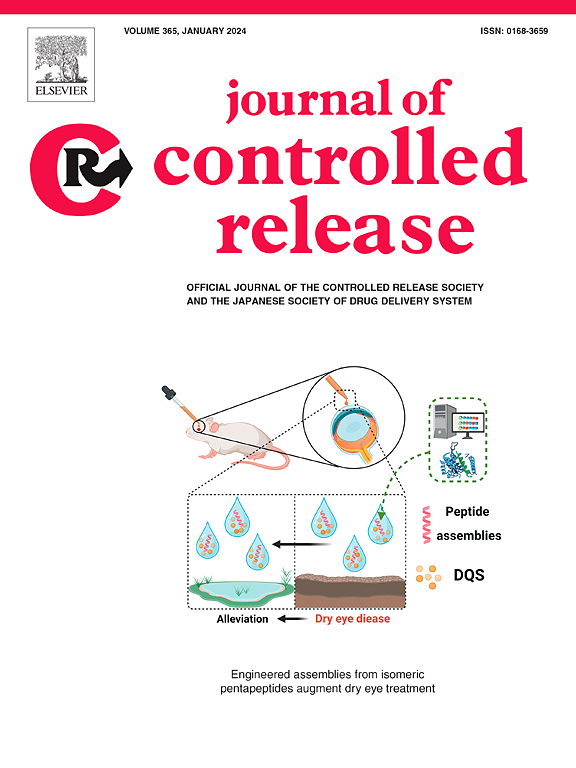金属-药物纳米囊泡对肝细胞癌治疗中葡萄糖代谢和免疫的协调调节。
IF 10.5
1区 医学
Q1 CHEMISTRY, MULTIDISCIPLINARY
引用次数: 0
摘要
高度免疫抑制的微环境,加上糖代谢紊乱,促进免疫逃避,损害癌症免疫治疗的有效性。为了解决这些挑战,我们开发了一种多功能的C-B-M-Mn纳米囊泡平台,以破坏肿瘤代谢并增强抗肿瘤免疫。该系统将BAY-876 (Glut1抑制剂)和MSA-2 (STING激动剂)包裹在纳米囊泡膜上,并通过与没食子酸修饰的壳聚糖低聚物在纳米囊泡核心内的螯合作用将Mn2+掺入。在酸性肿瘤条件下,纳米囊泡的表面电位转移到正电荷,促进细胞摄取。一旦被肿瘤细胞内化,C-B-M-Mn在酸性pH和高酯酶活性下释放其货物。抑制bay -876介导的糖酵解增加活性氧(ROS)的产生并触发线粒体DNA的释放,从而启动cGAS-STING信号通路。Mn2+增强cGAS敏感性,而MSA-2进一步激活STING,促进树突状细胞(DC)成熟和CD8+ T和自然杀伤细胞(NK)的募集。此外,这种代谢阻断降低了PD-L1的表达水平,减轻了免疫逃避。此外,Mn2+提供MRI对比增强,使成像和治疗同时进行。总的来说,这些发现强调了C-B-M-Mn平台作为一种有希望的综合糖代谢抑制和免疫治疗干预策略,以改善肝细胞癌(HCC)的治疗。本文章由计算机程序翻译,如有差异,请以英文原文为准。

Coordinated modulation of glucose metabolism and immunity via metal-drug nanovesicles for hepatocellular carcinoma therapy
A highly immunosuppressive microenvironment, along with disordered glucose metabolism, promotes immune evasion and compromises the effectiveness of cancer immunotherapy. To address these challenges, we developed a multifunctional C-B-M-Mn nanovesicle platform to disrupt tumor metabolism and enhance antitumor immunity. This system encapsulated BAY-876 (a Glut1 inhibitor) and MSA-2 (a STING agonist) in the nanovesicle membrane and incorporated Mn2+ through chelation with gallic acid-modified chitosan oligomers within the nanovesicle core. Under acidic tumor conditions, the surface potential of the nanovesicles shifted to positive charge, facilitating cellular uptake. Once internalized by tumor cells, C-B-M-Mn released its cargo in response to acidic pH and high esterase activity. BAY-876-mediated glycolysis inhibition increased reactive oxygen species (ROS) production and triggered the release of mitochondrial DNA, thereby priming the cGAS–STING signaling pathway. Mn2+ enhanced cGAS sensitivity, while MSA-2 further activated STING, promoting dendritic cell (DC) maturation and CD8+ T and natural killer (NK) cell recruitment. In addition, this metabolic blockade reduced PD-L1 expression levels and mitigated immune evasion. Additionally, Mn2+ provided MRI contrast enhancement, enabling simultaneous imaging and treatment. Collectively, these findings highlight the C-B-M-Mn platform as a promising strategy for integrated glucose metabolic inhibition and immunotherapeutic intervention to improve hepatocellular carcinoma (HCC) treatment.
求助全文
通过发布文献求助,成功后即可免费获取论文全文。
去求助
来源期刊

Journal of Controlled Release
医学-化学综合
CiteScore
18.50
自引率
5.60%
发文量
700
审稿时长
39 days
期刊介绍:
The Journal of Controlled Release (JCR) proudly serves as the Official Journal of the Controlled Release Society and the Japan Society of Drug Delivery System.
Dedicated to the broad field of delivery science and technology, JCR publishes high-quality research articles covering drug delivery systems and all facets of formulations. This includes the physicochemical and biological properties of drugs, design and characterization of dosage forms, release mechanisms, in vivo testing, and formulation research and development across pharmaceutical, diagnostic, agricultural, environmental, cosmetic, and food industries.
Priority is given to manuscripts that contribute to the fundamental understanding of principles or demonstrate the advantages of novel technologies in terms of safety and efficacy over current clinical standards. JCR strives to be a leading platform for advancements in delivery science and technology.
 求助内容:
求助内容: 应助结果提醒方式:
应助结果提醒方式:


